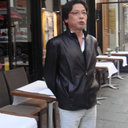[Large scale outbreak of Yersinia pseudotuberculosis serotype 5a infection at Noheji-machi in Aomori Prefecture].
Sleutelwoorden
Abstract
In June 1991, there were large scale outbreaks of Yersinia pseudotuberculosis at 4 primary schools and 1 junior high-school in Noheji-machi in Aomori Prefecture. A total of 732 patients (725 pupils and school children, 7 teachers and personnel) were affected and 134 were hospitalized. Sex ratio of incidence was 1.1:1.0 without appreciable difference. Clinical symptoms (478 patients) were represented frequently by pyrexia (86.4%), eruption (73.8%), abdominal pain (66.7%), vomiting nausea (63.4%), etc., and were characterized by a strawberry tongue, pharyngeal redness, membranous desquamation of the fingers and arthralgia during convalescence. Yersinia pseudotuberculosis was isolated from 27 (81.8%) of 33 patients stool specimens, 1 waste water specimen and 2 (11.7%) of cooking employees' stool specimens. The isolates were confirmed serotype 5a, and positive for calcium-dependency and autoagglutination, and harboring 40-50 megadalton virulent plasmid. Restrictive endonuclease digestive pattern of plasmid proved to be identical. In many cases, patients' serum antibody titer showed a significant increase ratio to the isolated strain. In term of drug susceptibility, all the strains were sensitive to cefem, penicillin and amino-glycoside series and resistant to macrolide and sulfa series. The infectious source was limited to the school feeding, but the responsible food remained unknown. Mean latency and exposure day were presumed to be 6.5 days and May 30, respectively.


